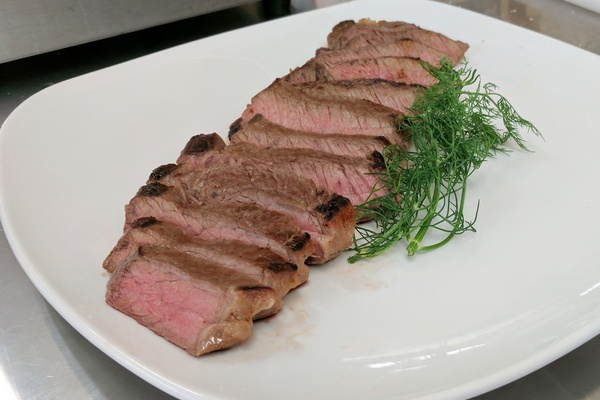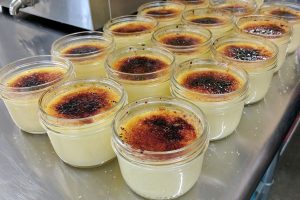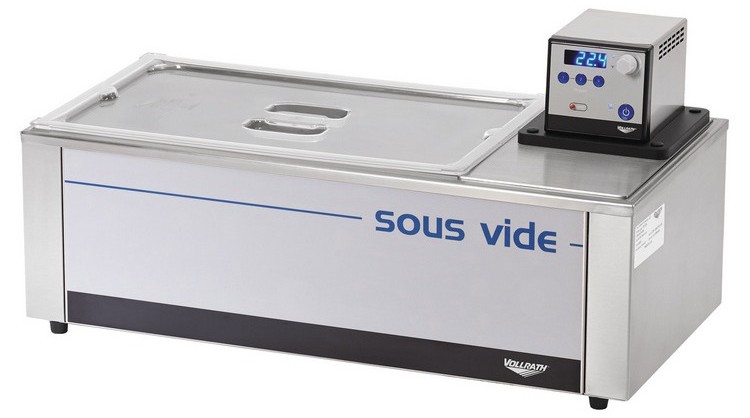Sous Vide is a non-traditional cooking method. Traditional cooking methods such as roasting and grilling have been around for centuries. With practice, one can master these skills to produce predictable results. Time and temperature are always the most important factors to manage when cooking. Different cooking methods present different challenges for managing both.
With roasting, for example, the cooking temperature can be a challenge. Usually, the oven temperature is set higher than the desired temperature of doneness. Knowing exactly when to take the roast out of the oven also presents a challenge. Usually, there is a very small window of time between an undercooked or overcooked roast. Grilling also has its own unique challenges such as fire management. Doneness on grilled foods can yield less than consistent results. The center of the steak may be a perfect medium, but the edges of the steak are more medium-well to well done.
Enter Sous Vide
What if there was a cooking method that could yield more consistent, precise results? That’s where sous vide comes in. Sous vide (pronounced like sue veed) is a cooking method where food cooks in a heat-safe bag while submerged in a heated water bath. The most often used equipment for cooking sous vide is an immersion circulator. The immersion circulator attaches to the water bath container. It contains a heating element to heat the water and an impeller to circulate it. These two parts work together to keep the water at a precise temperature.
So what does this mean for the cook using the sous vide method? How does it make a difference? What makes sous vide stand out from other traditional cooking methods? To answer these questions, we will cover four factors than make the sous vide method shine.
Precision
First, sous vide cooking is very precise. Let’s say you are preparing steak and you want to cook it to medium, about 140 °F. If you are grilling the steak, the temperature of your coals could be anywhere from 325 °F to 600 °F. It takes skill and practice to control that fire and to know when to pull the steak off the grill. Even after you take it off the grill, the temperature of the steak will still rise a few degrees. That’s because of carry-over cooking since the fire is much hotter than you want your steak.

Sous vide cooked steak after pan searing and slicing
So how can the sous vide method solve this problem? When you cook sous vide, you always know what temperature setting to use. That’s because the temperature you use is equal to the temperature you desire. So, to cook that medium steak, you set the temperature to 140 °F. Now the internal temperature of the steak never rises above that temperature! This is possible because of the heated water bath completely enveloping the food. The water bath raises the internal temperature gently without the possibility of overcooking. With sous vide, you remove the guesswork and achieve the precise temperature you want every time.
Flexibility
Sous vide cooking gives you more flexibility versus other traditional methods. This is because the window of time for perfect doneness is much greater with sous vide. Going back to our grilled steak example, there is a very narrow window of doneness. The amount of time between the steak being underdone and overdone is only a couple minutes at best. Yes, an experienced grill cook knows when to take that steak off the grill. But we all know that when the dinner rush is in full swing, things don’t always go according to plan.
With sous vide cooking, the window of doneness for that same steak is more than one hour! Remember, the internal temperature will never rise above the temperature of the water. This gives the chef much more flexibility. He doesn’t need to babysit the steak or take it off the grill at a certain time. He can continue to focus on other tasks until the moment he is ready for it. When he is ready, all he needs to do is take the steak out of the water bath and give it a quick sear on both sides.
Consistency
Traditional cooking methods don’t always deliver consistent doneness throughout the cooked product. This is especially true for seared, roasted, or grilled proteins. By the time the center reaches perfect doneness, the surrounding area is overdone. So while our grilled steak may be a perfect medium in the center, it is more medium-well to well towards the edges.
Now, imagine if you could have that perfect medium from edge to edge. That’s the kind of consistency that sous vide cooking delivers! You never have to set the temperature above your desired doneness. And so, the entire product cooks to perfection throughout. With sous vide cooking, you can achieve consistency unparalleled by other cooking methods.
Versatility
Sous vide cooking is not only useful for cooking proteins. Sous vide is useful for many, many other applications. To name only a few, sous vide can be used to cook yogurts, custards, vegetables, ice cream, and much, much more! It’s the precise temperature control of sous vide that makes this possible.

Sous vide cooked crème brûlée
Let’s look at crème brûlée for example. Crème brûlée is a custard thickened by the coagulation of egg protein. With the traditional methods, the chef pours the custard into ceramic ramekins. Next, he places the ramekins into a baking dish or steam table pan. He then pours water into the pan until the water level is even with the level of the custard in the ramekins. Finally, he places them into the oven on low heat. The water insulates the custard so that the temperature does not increase too quickly. If the internal temperature increases too fast, the egg protein over-coagulates. This, in turn, causes the texture to become too dense.
Sound complicated? There has to be an easier way, right? In fact, sous vide makes crème brûlée much simpler. Instead of the ramekins, pour the custard into individual mason jars. Afterward, seal the jars only finger tight and place them in the sous vide water bath. The finger tight seal allows air pressure to escape the submerged containers. The precise temperature control of sous vide never allows the custard to overcook. The result is the silkiest, smoothest crème brûlée you have ever tasted!
Getting Started with Sous Vide Today
Sous vide cooking is trending more and more in the restaurant industry today. That means you can find an increasing amount of resources for sous vide recipes in books and online. Getting started with sous vide cooking is simple. All you need is an immersion circulator, a compatible container for water, and food safe bags. Vollrath offers excellent sous vide set up that includes a circulator, a water container, and a cover. The water container is compatible with perforated steam table pan inserts which are great for sous vide eggs. A vacuum sealer makes a great companion piece for time management and portion control. It allows the user to pre-portion sous vides menu items prior to cooking. The chef can drop these vacuum-sealed portions directly into the water bath.
If you don’t have a vacuum sealer, you can still cook sous vide using the water displacement method. To use this method, first place your food product in a freezer bag. Next, with both hands, hold the bag open at the top. Then, submerge the product in the water bath, allowing the water pressure to press the air out of the bag. Next, leaving the seal of the bag open, fold the top edge of the bag over the edge of the water container. Finally, secure the bag to the container edge by placing a binder clip over the folded bag.
Remember at Dine Company, we are here to serve you! For more information on sous vide cooking or other products, call (866) 591-3463 Monday through Friday, 8 am-6 pm EST to speak to a knowledgeable sales associate. You can also visit our store at 3110 Preston Hwy in Louisville, KY to speak to a product specialist in person. Or, you can click here to shop our online store.


